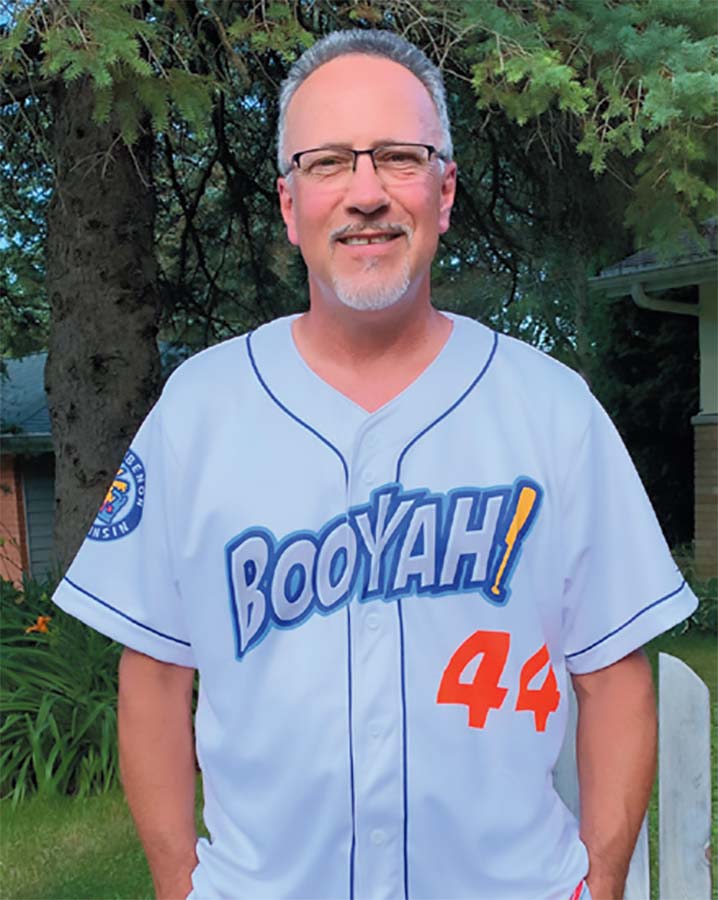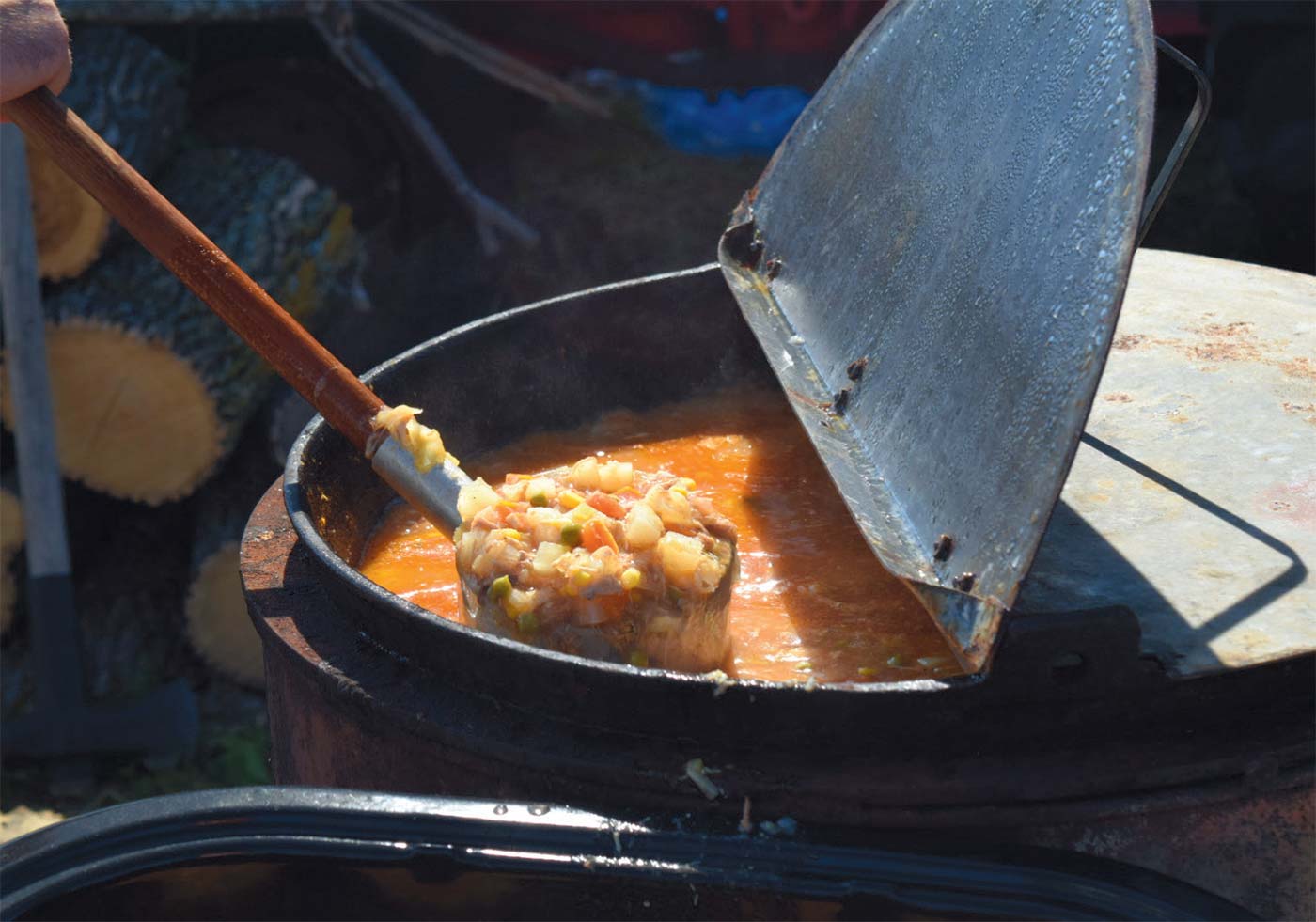TRADITION IS COOKING IN THIS FAMILY’S KETTLE
The Motquin family is keeping a taste of history alive.
Both the booyah recipe, as well as the cast-iron cooker it simmers in, have been used by three generations of the Motquin family. Mat, his father, Allan, and grandfather, Joe, have prepared chicken booyah over an outdoor fi re; each taking his turn leading the technique behind the six-to-eight-hour preparation of this family tradition for more than 50 years.
A childhood friend fi rst shared the Motquins’ recipe with Joe. The two made hundreds of bowls of booyah together for the Herman’s Club in Green Bay around the 1970s. This same recipe was later made for years by teams of volunteers, including Allan, at First Lutheran Church and St. Peter and Paul Parish in Green Bay.
Although supplementary ingredients and kettle size may vary depending on the cook, the popularity of this Belgian chicken-based soup has withstood the test of time and maintains its northeast Wisconsin regional appeal.
Chicken booyah is believed to have been made by both the Walloon and Flemish Belgian immigrants who settled in Door, Kewaunee and Brown Counties in the 1850s. According to Sue Havel, board member for the Belgian Heritage Center in Namur, Belgians were a frugal people and booyah most likely originated from what was available in their gardens around the time of Kermiss.
Traditionally, Kermiss was a three-day celebration held late in August to early October that began with a Mass or service of thanksgiving for the harvest. An opportunity to socialize, families gathered at churches or in back yards and traditional Belgian foods such booyah, bread and pies were part of the menu.
Booyah was made with chickens done laying eggs for the season. Simmering the meat tenderized it, and the slow cooking process extracted many flavors of different vegetables.
Questions still remain whether it should be considered a soup or stew. However, Havel said the original version was most likely of a thicker consistency due to the variety of ingredients— including the meat bones—that remained in the booyah when served.
“We haven’t changed a thing from when my grandfather made it, except for removing the bones,” Mat Motquin said. “I don’t want to. I have sampled many different varieties at local events or churches. There isn’t one that I like better.”
When finished, the Motquins’ 15- gallon heirloom kettle yields approximately 13 gallons of booyah. The recipe starts with four chickens weighing about 20 total pounds and fi ve pounds of oxtail cooked in fi ve gallons of water, along with onions and seasoned primarily with salt and pepper. The oxtails add fat to the broth as well as enhanced fl avors from the bone. After cooking for about two hours on a hot fl ame, the meat is stripped from the bones and put back into the kettle. Vegetables, including fresh cabbage, celery, carrots, potatoes as well as canned peas, green beans and corn, are then added at different times and in a particular sequence to enhance the soup’s flavor and to preserve its texture.
However, what gives the Motquin booyah its own unique taste is the family’s cast-iron kettle, which holds the flavor of previous batches and incorporates a hint of wood smoke. Whether making large batches over a wood fl ame or small versions on a stove top, cooking with cast iron is key, and the kettle’s rounded corners help prevent food from sticking or burning.
Mat, with the assistance of his wife, Stacy, and his dad, have been making booyah in his grandfather’s kettle for the past 10 years when it has been requested by family or friends for special events. Mat said that many people question cooking chicken booyah on an open fire in late summer when it’s hot. However, he loves cooking outdoors and spending extra time with family and friends while the soup’s flavor is slowly perfected. This is when things are at their very best. “I mainly do it for the fun!” Mat said.
One year the Motquin family made a batch in support of the Southern Door wrestling program and sold it as a complement to the chili already on the menu. Since then, Motquin booyah has been a featured food at the Southern Door Athletic Booster Club Arts and Craft Fair held each year in November.
“Preserving not just the recipe and practice, but the heritage and keeping a culture alive, is often done through food,” Havel said. “And booyah has been adopted by the whole outlying area, and is now served at all times of year,” Havel added. “Soup is always good!”
Today, communities in Door, Brown and Kewaunee Counties including Brussels and Namur, Rosiere and Champion, and Lincoln still celebrate Belgian Kermiss. For more information, please visit or contact the Belgian Heritage Center open Friday through Sunday from 10 a.m. – 4 p.m. through the end of October and located at 1255 County Road DK, Namur.

Mike Rabas
LIFETIME SUPPLY OF BOOYAH
WHILE WATCHING THE LOCAL NEWS one night, Mike Rabas heard about a contest to rename the Green Bay Bullfrogs, a collegiate summer baseball team in the Northwoods League. The rebranding effort was designed in conjunction with the team’s move from Joannes Stadium to Capital Credit Union Park in Ashwaubenon prior to the start of the 2019 season.
Rabas, who works as director of prevocational and support services at Sunshine House Inc. in Sturgeon Bay, thought about it just a little while, and came up with “Booyah.”
“Many professional sport team names in our area, like Packers and Brewers, originated with the people or culture unique to the Midwest,” he said. “Booyah is not only a fun word, but it also reflects northeastern Wisconsin more than anywhere else. If the team was looking for a regional name, I wanted to come up with a good one!”
The word also reminded him of a Navy and Coast Guard battle cry, “Hooyah!”
“With a team name like ‘Booyah’, I could envision fans having a lot of fun creating a good sport chant,” Rabas said.
He decided to submit his idea. After all, a love of baseball and booyah have always been part of Rabas’ life. He remembers eating booyah as a child with his parents at Luxemburg-Casco church picnics, and his children were highly involved in the game. His son played baseball from Little League to American Legion while his daughter, Michaela, managed her high school team and while in college worked as a trainer for another Northwoods team, the Madison Mallards.
After an online vote of the seven finalists was held, Booyah won as the favorite, and in November 2018 the Green Bay Booyah logo was introduced. Chicken, the most common ingredient, inspired the fierce rooster now featured on the team’s logo.
In what turned out to be a very memorable night with family and friends, Rabas threw the first pitch at the second home game in May. When the team found out he was the creative contest winner receiving this honor, he received a plethora of high-fives!
In addition to the recognition, Rabas was awarded baseball tickets for life at all Green Bay Booyah home games and availability to booyah any time he chooses. The team also debuted a 2,000-gallon World’s Largest Booyah Kettle and serves the popular soup at games. It’s all part of a regional recipe for fun each summer in Ashwaubenon





